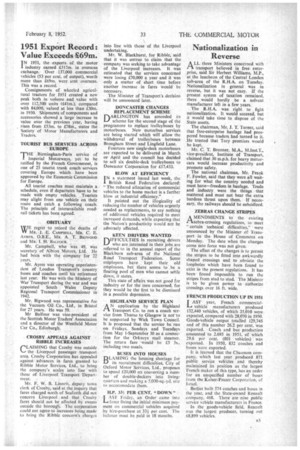Nationalization in Reverse
Page 37

If you've noticed an error in this article please click here to report it so we can fix it.
ALL three Ministers concerned with transport believed in free enterprise, said Sir Herbert Williams, M.P., at the luncheon of the Central London sub-area of the R.H.A. on Tuesday.
Nationalization in general was in reverse, but it was not easy. If the present system of taxation remained, there would hardly be a solvent manufacturer left in a few years.
The R.H.A. was right to fight nationalization. It would succeed, but it would take time to dispose of the State assets.
The chairman, Mr. J. T. Turner, said that free-enterprise haulage had pros pered because traders had turned to it. He trusted that Tory promises would be kept.
Mr. C. T. Brunner, M.A., M.Inst.T., vice-president, Institute of Transport, claimed that 30 m.p.h. for heavy motorcars would increase productivity and promote safety.
The national chairman, Mr. Frank F. Fowler, said that they were all wait ing for what the country needed and
must have—freedom in haulage. Trade and industry were the things that
mattered and must not bear the extra burdens thrust upon them. If necessary, the railways should be subsidized.
ZEBRAS CHANGE STRIPES
AMENDMENTS to the existing zebra-crossing regulations, to meet 6' certain technical difficulties," ' were announced by the Minister of Transport in the House of Commons on Monday. The date when the changes come into force was not given.
The effect of the changes is to permit the stripes to be fitted into awkwardly shaped crossings and to obviate the loopholes which have been found to exist in the present regulations. It has been found impossible to run the stripes fromstud to stud. The Minister is to be given power to • authorize crossings over 16 ft. wide.
FRENCH PRODUCTION UP IN 1951 I AST year, French commercial.1-4 vehicle manufacturers produced 132,440 vehicles, of which 35,010 were • exported, compared with 28,070 in 1950_ Goods-vehicle output totalled 129,745 and of this number 26.2 per cent, was exported. Coach and bus production amounted to 2,695 in 1951, of which 29.6 per cent. (801 vehicles) was exported. In 1950, 832 coaches and buses were exported.
It is learned that the Chausson company, which last year produced 871 public service veh:cles and thereby maintained its position as the largest French maker of this type, has an order for an unspecified number of buses from the Kaiser-Frazer Corpciration, of Berliet built 574 coaches and buses in the year, and the State-owned Renatilt company, 468. There are nine public service vehicle manufacturers in France.
In the goods-vehicle field, Renault was the largest producer, turning out 68,899 vehicles.




























































































